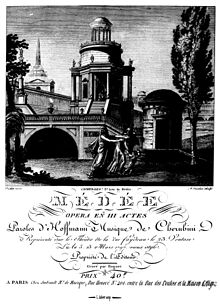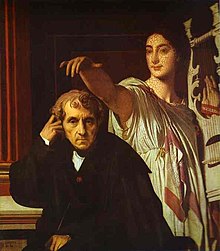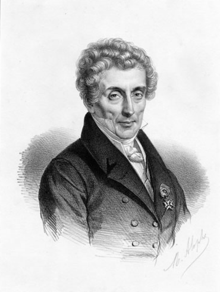Luigi Cherubini
루이지 케루비니(Luigi Cherubini, 1760-1842)는 이탈리아의 오페라 및 종교 음악 작곡가이다. 이탈리아에서 배운 뒤 영국·프랑스에 초빙되었고, 1788년 28세 때 파리에 정주했으며 프랑스인의 취미에 맞는 화려한 오페라를 작곡하여 인기를 모았다. 1795년 파리에 창설된 파리 음악원의 감독에 취임했고, 그 뒤 한동안 나폴레옹 보나파르트의 음악감독으로도 있었으나 나폴레옹과 의견이 맞지 않아 퇴직하였다. 1822년 파리 음악원 원장이 되었다. 천재소년 리스트의 입학을 외국인이라는 이유로 거절하였다. 1841년 노령 때문에 원장직을 사임, 그동안 빈이나 런던을 방문하여 자기의 작품을 발표했다. 그의 대표작은 오페라 <메디아>(1797)와 <물긷기>(1800)로 베토벤은 케루비니의 오페라를 높이 평가했고 성악의 취급에 관하여 큰 영향을 받았다.
(1760 - 1842 / 영조40년-헌종8년, 82세) was an Italian composer who spent most of his working life in France. His most significant compositions are operas and sacred music. Beethoven regarded
Cherubini as the greatest of his contemporaries.
( 프랑스에서 주로 활동한 이탈리아 출신 음악가. 오페라와 종교음악에 뛰어난 곡이많다. 베토벤도 당대의 거목으로 평가했다.)
Symphony in D-major (1815/55세) - 유일한 교향곡
Mov.I: Largo - Allegro 00:00
Mov.II: Larghetto cantabile 10:18
Mov.III: Menuetto: Allegro non tanto - Trio 18:32
Mov.IV: Finale: Allegro assai 23:45
Orchestra: Orchestra delle Toscana
Conductor: Donato Renzetti
===============================================================================
* Requiem in C minor -베토벤, 슈만, 브람스가 격찬 한 곡.
(The work was greatly admired by Beethoven, Schumann and Brahms.)
I. Introitus et Kyrie [0:00]
II. Graduale [7:35]
III. Sequentia: Dies irae [8:52]
IV. Domine Jesu Christe [16:46]
- Hostias [22:40]
V. Sanctus et Benedictus [29:27]
VI. Pie Jesu [30:41]
VII. Agnus Dei [34:08]
Boston Baroque
Martin Pearlman
performed on period instruments
Memorial to King Louis XVI and Queen Marie Antoinette, by Edme Gaulle and Pierre Petitot
=================================================================
Cherubini 는 피렌체에서 Maria Luigi Carlo Zenobio Salvatore Cherubini 라는 이름으로 태어났으나 출생일은 확실하지 않다.
6세에 합시코드의 대가였던 아버지 Bartolomeo로부터 음악을 배우기 시작했다.. 신동으로서의 면모를 보이기 시작한 그는 대위법과 극적인 스타일 등에 대하여 공부했고, 13세에 이르러 몇몇 종교작품을 작곡하게되었다..1780년 20살의 나이에 미래에 황제 레오폴트 2세가 되었던 Grand Duke of Tuscany (투스카니 공작)이 주는 장학금으로 볼로냐와 밀란에 유학하여 오페라 작곡가인 Giuseppe Sarti에게 배웠다..
1806년 연출되었던 Faniska는 특별히 베토벤과 하이든으로부터의 찬사와 함께 열화와 같은 호응을 받았던 이 시기의 거의 유일한 작품이었다.
Requiem in C-minor (1816)는 프랑스왕 루이 16세의 처형기 념일에 맞추어 작곡되었으며, 압도적인 성공을 거두었다. 이 작품은 베토벤,슈만, 브람스의 격찬을 받은 작품으로도 유명하다.
케루비니는 자신의 삶 동안 Chevalier de la Legion d'honneur (1814) 와 Membre de l'Academie des Beaux-Arts (1815) 등과 같은 프랑스가 주는 가장 존귀하고 저명한 명예를 얻었다.1841년 최고의 음악가에게 수여되는 Commandeur de la Legion d'honneur라는 호칭을 받았다.1842년 81세를 일기로 삶을 마쳤으며, Pere Lachaise Cemetery에 안장되었다.
< 네이버 블로거 '레인트리 님' 번역에서 발췌- 원문은 영어위키백과 >
Early years[edit]
Cherubini was born Maria Luigi Carlo Zenobio Salvatore Cherubini in Florence in 1760. There is uncertainty about his exact date of birth. Although 14 September is sometimes stated, evidence from baptismal records and Cherubini himself suggests the 8th is correct. Perhaps the strongest evidence is his first name, Maria, which is traditional for a child born on 8 September, the feast-day of the Nativity of the Virgin.[1] His instruction in music began at the age of six with his father, Bartolomeo, maestro al cembalo ("Master of the harpsichord", in other words, ensemble leader from the harpsichord). Considered a child prodigy, Cherubini studied counterpoint and dramatic style at an early age. By the time he was thirteen, he had composed several religious works.
Adulthood and first operas[edit]
In 1780, he was awarded a scholarship by the Grand Duke of Tuscany to study music in Bologna and Milan.[1] Cherubini's early opera serie used libretti by Apostolo Zeno, Metastasio (Pietro Trapassi), and others that adhered closely to standard dramatic conventions. His music was strongly influenced by Niccolò Jommelli, Tommaso Traetta, and Antonio Sacchini, who were the leading Italian composers of the day. The first of his two comic works, Lo sposo di tre e marito di nessuna, premiered at a Venetian theater in November 1783.[1]
Feeling constrained by Italian traditions and eager to experiment, Cherubini traveled to London in 1785 where he produced two opere serie and an opera buffa for the King's Theatre. In the same year, he made an excursion to Paris with his friend the violinist Giovanni Battista Viotti, who presented him to Marie Antoinette and Parisian society. Cherubini received an important commission to write Démophoon to a French libretto by Jean-François Marmontel that would be his first tragédie en musique. Except for a brief return trip to London and to Turin for an opera seria commissioned by King Victor Amadeus III, Cherubini spent the rest of his life in France[1] where he was initiated into Grand Orient de France "Saint-Jean de Palestine" Masonic Lodge in 1784.
French assimilation[edit]

Cherubini adopted the French version of his name, Marie-Louis-Charles-Zénobi-Salvador Cherubini; this appears in all extant documents that show his full name after 1790,[1] though his Italian name is favored nowadays. Performances of Démophon were favorably received at the Grand Opéra in 1788. With Viotti's help, the Théâtre de Monsieur in the Tuileries appointed Cherubini as its director in 1789. Three years later, after a move to the rue Feydeau and the fall of the monarchy, the company became known as the Théâtre Feydeau. This position gave Cherubini the opportunity to read countless libretti and choose one that best suited his temperament.
Cherubini's music began to show more originality and daring. His first major success was Lodoïska (1791), which was admired for its realistic heroism. This was followed by Elisa (1794), set in the Swiss Alps, and Médée (1797), Cherubini's best-known work. Les deux journées (1800), in which Cherubini simplified his style, was a popular success. These and other operas were premièred at the Théâtre Feydeau or the Opéra-Comique. Feeling financially secure, he married Anne Cécile Tourette in 1794 and began a family of three children.
The fallout from the French Revolution affected Cherubini until the end of his life. Politics forced him to hide his connections with the former aristocracy and seek governmental appointments. Although Napoleon found him too complex, Cherubini wrote at least one patriotic work per year for more than a decade.[1] He was appointed Napoleon's director of music in Vienna for part of 1805 and 1806, whereupon he conducted several of his works in that city.
In 1808 Cherubini was elected an associated member of the Royal Institute of the Netherlands.[5]

From opera to church music[edit]
After Les deux journées, Parisian audiences began to favor younger composers such as Boieldieu. Cherubini's opera-ballet Anacréon was an outright failure and most stage works after it did not achieve success. Faniska, produced in 1806, was an exception, receiving an enthusiastic response, in particular by Haydn and Beethoven. Les Abencérages (1813), an heroic drama set in Spain during the last days of the Moorish kingdom of Granada, was Cherubini's attempt to compete with Spontini's La vestale; it received critical praise but few performances.
Disappointed with his lack of acclaim in the theater, Cherubini turned increasingly to church music, writing seven masses, two requiems, and many shorter pieces. During this period (under the restored monarchy) he was appointed Surintendant de la Musique du Roi, a position he would hold until the fall of Charles X (1830). In 1815 London's Royal Philharmonic Society commissioned him to write a symphony, an overture, and a composition for chorus and orchestra, the performances of which he went especially to London to conduct, increasing his fame.
Cherubini's Requiem in C minor (1816), commemorating the anniversary of the execution of King Louis XVI of France, was a huge success. The work was greatly admired by Beethoven, Schumann and Brahms. In 1836, Cherubini wrote a Requiem in D minor to be performed at his own funeral. It is for male choir only, as the religious authorities had criticised his use of female voices in the earlier work.
Old age and legacy[edit]

In 1822, Cherubini became director of the Conservatoire and completed his textbook, Cours de contrepoint et de fugue, in 1835. His role at the Conservatoire brought him into conflict with the young Hector Berlioz, who portrayed the old composer in his memoirs as a crotchety pedant. Some critics, such as Basil Deane, maintain that Berlioz's depiction has distorted Cherubini's image with posterity. There are many allusions to Cherubini's personal irritability among his contemporaries; Adolphe Adam wrote, "some maintain his temper was very even, because he was always angry." Nevertheless, Cherubini had many friends, including Szymanowska, Rossini, Chopin and, above all, the artist Ingres. The two had mutual interests: Cherubini was a keen amateur painter and Ingres enjoyed practising the violin. In 1841, Ingres produced the most celebrated portrait of the old composer.
Although chamber music does not make up a large portion of his output, what he did write was important. Wilhelm Altmann, writing in his Handbuch für Streichquartettspieler (Handbook for String Quartet Players) about Cherubini's six string quartets, stated that they are first rate and regarded Nos. 1 and 3 as masterworks. His String Quintet for two violins, viola and two cellos is also considered a first-rate work.
During his lifetime, Cherubini received France's highest and most prestigious honors. These included the Chevalier de la Légion d'honneur (1814) and Membre de l'Académie des Beaux-Arts (1815). In 1841, he was made Commandeur de la Légion d'honneur, the first musician to receive that title.[6]
Cherubini died in Paris in 1842 at age 81 and is buried at Père Lachaise Cemetery, just four metres from his friend Chopin. His tomb was designed by the architect Achille Leclère and includes a figure by the sculptor Augustin-Alexandre Dumont representing "Music" crowning a bust of the composer with a wreath.
Works[edit]
Orchestral music[edit]
- Overture in G (1815)
- Symphony in D major (1815)
- Marche funèbre (1820)
Chamber music[edit]
- String Quartet No. 1 in E-flat (1814)
- String Quartet No. 2 in C (1829) - transcription of Symphony in D major with new second movement
- String Quartet No. 3 in D minor (1834)
- String Quartet No. 4 in E (1835)
- String Quartet No. 5 in F (1835)
- String Quartet No. 6 in A minor (1837)
- String Quintet (2 violins, viola, 2 cellos) in E minor (1837)
Masses and sections of the Mass[edit]
- Five masses (written 1773–1776, lost)
- Messe solennelle brève in B-flat (1805, dubious)
- Credo a capella for eight voices and organ (1806)
- Mass in A for three voices (1809, dubious)
- Messe de Chimay in F (1809)
- Missa solemnis in D minor (1811) per il Principe Esterházy
- Mass (4th messe solennelle) in C (1816)
- Credo in D (1816)
- Requiem in C minor for mixed chorus (1816) in memory of Louis XVI
- Missa solemnis in E (1818)
- Mass in G (1819) for the Coronation of Louis XVIII
- Mass in B-flat (1821, dubious)
- Messe solennelle in A for the Coronation of Charles X (1825)
- Requiem in D minor for male chorus (1836) written for his own funeral[7]
Motets and other choral works[edit]
- Cantata Amphion (1786)
- Cantata Circé (premiered 1789)
- Trois chœrs: Incidental music for the play La Mort de Mirabeau by Jean-Baptiste Pujoulx (1791)
- Cantata Clytemnestra (1794)
- Cantata Hymne au printemps ("Hymn to Spring") (1815)
- Hymne du Panthéon (1794) [8]
- 38 motets
Operas[edit]
Teaching manuals[edit]
'♣ 음악 감상실 ♣ > * 음악가 별' 카테고리의 다른 글
| [벨기에]François-Joseph Fétis (0) | 2014.09.12 |
|---|---|
| Fodor - Piano Concerto in g-minor, Op. 12 (0) | 2014.09.12 |
| Cherubini: Ouvertures from Giulio Sabino, Lodoïska, Elisa, Faniska and a Concert Ouverture (0) | 2014.09.11 |
| Johann Wilhelm Wilms 협주곡 외 모음 (0) | 2014.09.10 |
| [네델란드계 독일]Johann Wilhelm Wilms (0) | 2014.09.10 |

